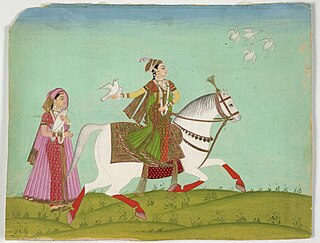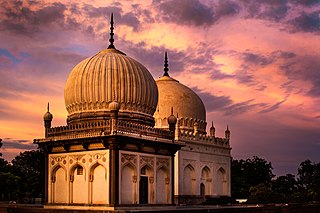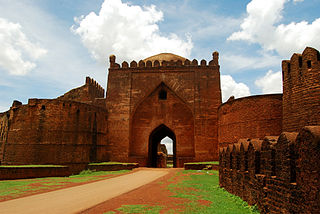| |||||
| Centuries: | |||||
|---|---|---|---|---|---|
| Decades: | |||||
| See also: | List of years in India Timeline of Indian history | ||||
Events from the year 1590 in India.
| |||||
| Centuries: | |||||
|---|---|---|---|---|---|
| Decades: | |||||
| See also: | List of years in India Timeline of Indian history | ||||
Events from the year 1590 in India.

The Deccan sultanates were five late-medieval Indian kingdoms—on the Deccan Plateau between the Krishna River and the Vindhya Range—that were ruled by Muslim dynasties: namely Ahmadnagar, Berar, Bidar, Bijapur, and Golconda. The sultanates had become independent during the break-up of the Bahmani Sultanate. The five sultanates owed their existence to the declaration of independence of Ahmadnagar in 1490, followed by Bijapur and Berar in the same year. Golconda became independent in 1518, and Bidar in 1528.

The Qutb Shahi dynasty was a Persianate Shia Islamic dynasty of Turkoman origin that ruled the Sultanate of Golkonda in southern India. After the collapse of Bahmani Sultanate, the Qutb Shahi dynasty was established in 1512 AD by Sultan-Quli Qutb-ul-Mulk, better known though less correctly referred to in English as "Quli Qutb Shah".

Ibrahim Qutb Shah Wali, also known by his Telugu names Malki BhaRama and Ibharama Cakravarti, was the fourth monarch of the kingdom of Golconda in southern India. He was the first of the Qutb Shahi dynasty to use the title "Sultan". He ruled from 1550 to 1580. He lived for seven years in exile at the court of Vijayanagara as an honoured guest of Rama Raya. Ibrahim is known for patronizing Telugu extensively because he was moved by a genuine love for the language.
Muhammad Quli Qutb Shah was the fifth sultan of the Qutb Shahi dynasty of Golkonda and founded the city of Hyderabad, in South-central India and built its architectural centerpiece, the Charminar. He was an able administrator and his reign is considered one of the high points of the Qutb Shahi dynasty. He ascended to the throne in 1580 at the age of 15 and ruled for 31 years.

The Adil Shahi or Adilshahi, was a Shia, and later Sunni Muslim, dynasty founded by Yusuf Adil Shah, that ruled the Sultanate of Bijapur, centred on present-day Bijapur district, Karnataka in India, in the Western area of the Deccan region of Southern India from 1489 to 1686. Bijapur had been a province of the Bahmani Sultanate (1347–1518), before its political decline in the last quarter of the 15th century and eventual break-up in 1518. The Bijapur Sultanate was absorbed into the Mughal Empire on 12 September 1686, after its conquest by the Emperor Aurangzeb.
Sultan Quli Qutb-ul-Mulk, more often though less correctly referred to in English as Quli Qutb Shah (1485–1543), was the founder of the Qutb Shahi dynasty, which ruled the Sultanate of Golconda in southern India from 1518 to 1687. Of Turkmen origin and born in Persia, he originally served the Bahmani sultan, and was awarded the title Qutb-ul-Mulk as military chief; he eventually took control of Golconda.

Abul Hasan Qutb Shah, also known as Abul Hasan Tana Shah was the eighth and last ruler of the Qutb Shahi dynasty, sovereign of the Kingdom of Golconda in South India. He ruled from 1672 to 1686. The last Sultan of this Sunni Islamic dynasty, Tana Shah is remembered as an inclusive ruler. Instead of appointing only Muslims as ministers, he appointed Brahmin Hindus such as Madanna and Akkanna brothers as ministers in charge of tax collection and exchequer. Towards the end of his reign, one of his Muslim generals defected to the Mughal Empire, who then complained to Aurangzeb about the rising power of the Hindus as ministers in his Golconda Sultanate. Aurangzeb sent a regiment led by his son, who beheaded Tana Shah's Hindu ministers and plundered the Sultanate. In 1687, Aurangzeb ordered an arrest of Tana Shah, who was then imprisoned at the Daulatabad Fort. He died in prison in 1699.

Ibrahim Adil Shah II was king of the Sultanate of Bijapur and a member of the Adil Shahi dynasty. Under his reign the dynasty had its greatest period as he extended its frontier as far south as Mysore. He was a skilful administrator, artist, poet and a generous patron of the arts. He reverted to the Sunni orthodoxy of Islam, but remained tolerant of other religions, including Christianity. However, during his reign high-ranking Shiite immigrants became unwelcome and in 1590, he ordered the confinement of criers who read the khutba in the Shia form. After his reign, increasing weakness permitted Mughal encroachment and the successful revolt of the Maratha king Shivaji, who killed the Bijapur general Afzal Khan and scattered his army. The dynasty left a tradition of cosmopolitan culture and artistic patronage whose architectural remains are to be seen in the capital city of Bijapur.
Firishta or Ferešte, full name Muhammad Qasim Hindu Shah Astarabadi, was a Persian historian, who later settled in India and served the Deccan Sultans as their court historian. He was born in 1570 and died in 1620. The name Firishta means 'angel' in Persian.

Bidar sultanate was one of the Deccan sultanates of late medieval southern India. The sultanate emerged under the rule of Qasim Barid I in 1492 and leadership passed to his sons. Starting from the 1580s, a wave of successions occurred in the rulership of the dynasty which ended in 1609 under the last Sultan Amir Barid III who was eventually defeated in 1619 by the Bijapur sultan Ibrahim Adil Shah II. Bidar became annexed into the Bijapur Sultanate.

Sultana Chand Bibi was an Indian ruler and warrior. She acted as the Regent of Bijapur Sultanate during the minority of Ibrahim Adil Shah II in 1580-1590, and regent of Ahmednagar Sultanate during the minority of her great nephew Bahadur Shah in 1595-1600. Chand Bibi is best known for defending Ahmednagar against the Mughal forces of Emperor Akbar in 1595.

On the death of Mohammed Adil Shah, Sultan of Bijapur on 4 November 1656, Ali Adil Shah II, a youth of eighteen, succeeded to the throne of Bijapur through the efforts of the Prime Minister Khan Muhammad and the Queen, Badi Sahiba, sister of Qutb Shah of Golkonda.

The Qutub Shahi Tombs are located in the Ibrahim Bagh, close to the famous Golconda Fort in Hyderabad, India. They contain the tombs and mosques built by the various kings of the Qutub Shahi dynasty. The galleries of the smaller tombs are of a single storey while the larger ones are two storied. In the centre of each tomb is a sarcophagus which overlies the actual burial vault in a crypt below. The domes were originally overlaid with blue and green tiles, of which only a few pieces now remain.

The Bijapur Fort is located in the Bijapur city in Bijapur District of the Indian state of Karnataka. Bijapur fort has a plethora of historical monuments of architectural importance built during the rule of Adil Shahi dynasty.

Deccani Architecture refers to the architectural styles developed during the Deccan sultanate period. The Deccan sultanates were five dynasties that ruled late medieval kingdoms, namely, Bijapur, Golkonda, Ahmadnagar, Bidar, and Berar in south-western India. The Deccan sultanates were located on the Deccan Plateau. Their architecture was a regional variant of Indo-Islamic architecture, heavily influenced by the styles of the Delhi Sultanate and later Mughal architecture, but sometimes also directly from Persia and Central Asia.
Mahmood Shah or Shihab-Ud-Din Mahmud was the sultan of the Bahmani Sultanate from 1482 until his death in 1518. His long rule is noted for the disintegration of the sultanate and the creation of the independent Deccan sultanates.

Qutb Shahi architecture is the distinct style of Indo-Islamic architecture developed during the reign of the Qutb Shahi dynasty, also known as the Golconda Sultanate.
Khunza Humayun Begum also known as Kurja Sultana, Khanzada Humayun Sultana and Khunzah Humayun, was the regent of the Ahmadnagar Sultanate between 1565 and 1571, during the minority of her son sultan Murtaza Nizam Shah I.
Deccani literature The literature was produced in Deccani dialect of Urdu language writing system. The earliest forms of Deccani literature are in the form of Sufi and Bhakti texts with poetic genres. The timeline of Deccani literature is divided into two periods: medieval (1300-1800) and modern. Though Medieval Deccani literature consists of Mathnawi it also has various genres, including works of "Fakhruddin Nizami" Kadam Rao Padam Rao, Deccani Masnavi originated during the Bahmani Sultanate of Deccan in the early 14th and 15th century; they are written in rhyming couplets in Deccani Urdu, the use of grammar and meter are similar with Masnavi of Urdu language.